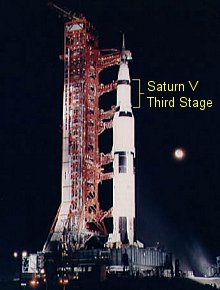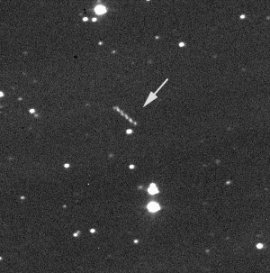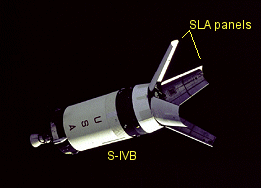 J002E3
couldn't be any of those things. "There is an outside chance that it might
be one of the Spacecraft-Lunar Module Adapter (SLA) panels," adds Chodas,
"although J002E3 appears to be too bright for one of those."
J002E3
couldn't be any of those things. "There is an outside chance that it might
be one of the Spacecraft-Lunar Module Adapter (SLA) panels," adds Chodas,
"although J002E3 appears to be too bright for one of those."60ft Long Mystery Object Spotted in Near Earth Orbit!
NASA scientists have revealed that there is something odd circling our planet. The small object that is 60-ft long, and rotates once every minute or so was first spotted by amateur astronomer Bill Yeung on Sept. 3rd, 2002 in the constellation Pisces. He named it J002E3.
The mystery object seems to have appeared from nowhere as Automated asteroid surveys which scan the skies every few weeks did not pick up any sign of Yeung's object earlier this year. "It must have entered Earth orbit recently," says Paul Chodas of NASA's Near-Earth Object Program at JPL. "But it doesn't match any recently-launched spacecraft."
 Could
it be an alien spaceship? "If it is," says Chodas, "the aliens
aren't good pilots. J002E3 is in a chaotic orbit. It loops around Earth once
every 48 days or so, coming as close to our planet as the Moon and ranging as
far away as two lunar distances." There's no evidence that the speck is
moving under its own power. The orbit is constantly changing because of
gravitational perturbations by the Sun and Moon.
Could
it be an alien spaceship? "If it is," says Chodas, "the aliens
aren't good pilots. J002E3 is in a chaotic orbit. It loops around Earth once
every 48 days or so, coming as close to our planet as the Moon and ranging as
far away as two lunar distances." There's no evidence that the speck is
moving under its own power. The orbit is constantly changing because of
gravitational perturbations by the Sun and Moon.
At first Yeung and others thought J002E3 might be a small asteroid--a reasonable guess. The object is as bright as a 30m-wide space rock and it's moving about as fast as an asteroid should move. Mars and Jupiter have captured asteroid moons before; perhaps Earth had done the same.
However, University of Arizona astronomers found on Sept. 12th when they measured the spectrum of sunlight reflected from J002E3 something even more peculiar. "The colors were consistent with ... white titanium dioxide paint--the type of paint NASA used on Apollo moon rockets 30 years ago," says Carl Hergenrother, who conducted the study with colleague Robert Whiteley.
So if this is a part of an Apollo craft, where has it been all this time?
"Orbiting the Sun," answers Chodas. "I've traced the motion of J002E3 backwards in time to find out where it's been," he explains. Apparently, J002E3 left Earth in 1971, went around the Sun 30 or so times, and came back again. Chodas, a expert in planetary motion who has seen plenty of complicated orbits, says "I've never seen anything like this."
At first glance, J002E3 would seem to be from Apollo 14. That mission began in January of 1971, and according to Chodas' calculations J002E3 broke out of Earth orbit in March of the same year. There's a problem, though: NASA has accounted for all the big pieces of the Apollo 14 spacecraft. None are missing.
Chodas inventories the mission: On Jan. 31, 1971, a Saturn V rocket blasted off from Florida with Al Shepard, Ed Mitchell and Stuart Roosa inside. Two stages of the rocket fell back to Earth when they exhausted their fuel. A third stage, the S-IVB fuel tank and rocket engine, which propelled the crew from Earth-orbit toward the Moon, was likewise discarded. The S-IVB, however, did not fall back to Earth; it hit the Moon. Ground controllers guided it there on purpose to provide an impact for lunar seismic monitoring stations. The lunar module Antares was also deliberately crashed--more data for the seismic network. The command module Kitty Hawk returned the crew to Earth.
 J002E3
couldn't be any of those things. "There is an outside chance that it might
be one of the Spacecraft-Lunar Module Adapter (SLA) panels," adds Chodas,
"although J002E3 appears to be too bright for one of those."
J002E3
couldn't be any of those things. "There is an outside chance that it might
be one of the Spacecraft-Lunar Module Adapter (SLA) panels," adds Chodas,
"although J002E3 appears to be too bright for one of those."
Right: The Apollo 12 Saturn V rocket awaits launch in 1969.
Another possibility is that J002E3 is an S-IVB from Apollo 12. Unlike Apollo 14, Apollo 12's S-IVB did not crash into the Moon. The crew jettisoned it on Nov. 15, 1969, when it was nearly out of fuel. Once the astronauts were safely away, ground controllers ignited the S-IVB's engine. They meant to send the 60-ft-long tank into a Sun-centered orbit, but something went wrong; the burn lasted too long. Instead of circling the Sun, the S-IVB entered a barely-stable orbit around the Earth and Moon "much like the current orbit of J002E3," notes Chodas.
Eventually, the Apollo 12 S-IVB vanished--no one knows when. Perhaps gravitational tugs from the Sun and Moon accumulated until they nudged the engine away from Earth in 1971. In this scenario, it would have circled the Sun for 31 years until it was re-captured by Earth's gravity in 2002.
"It's plausible," says Chodas, "but still speculative."
Whatever J002E3 is, it's taking a fantastic journey through the solar system--and it's not done yet. Chodas' calculations indicate that J002E3 will leave Earth again in June 2003 to resume its orbit around the Sun. "Thirty years from now," he notes, "it might come back again."
 If
it does, perhaps it will be greeted by human explorers on regular "milk
runs" between the Earth and Moon. They might detour briefly and discover,
once and for all, what J002E3 really is: a historical attraction, maybe, or
something wholly unexpected....
If
it does, perhaps it will be greeted by human explorers on regular "milk
runs" between the Earth and Moon. They might detour briefly and discover,
once and for all, what J002E3 really is: a historical attraction, maybe, or
something wholly unexpected....
For now the best we can do is watch J002E3 from afar--an unresolved speck of light easily detected by 8" to 10" telescopes with CCD cameras. This week J002E3 is gliding through the constellation Taurus. Where will it go next? Find out by visiting JPL's Near-Earth Object Program web site, which offers a helpful ephemeris for observers. J002E3 won't be here long, so catch it while you can!
This story originally appeared on http://science.nasa.gov